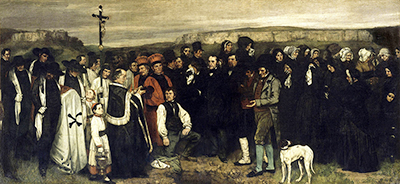A Burial at Ornans is one of Gustave Courbet's most famous and complex paintings, and was completed in 1851. This artist's honest depiction of the lives of ordinary folk was met with derision, for his approach was groundbreaking and challenged the very idea of what art could and should be.
Whilst being middle-class, the fact that the individuals in this painting were all from rural communities would immediately draw questions as to their suitability for this artwork from the somewhat snobby city dewllers of that period. Paris could not understand why an artist of this level would wish to waste his time on such people. Such snobbery has certainly softened in more recent generations and there is a greater tolerance of different artistic styles and content. A Burial at Ornans played a part in this change, by challenging the established view.
As the head of the French movememnt towards Realism, Courbet was completely used to ruffling artistic feathers within the art world and most of his work during this period was deemed controversial, despite the general acceptance of his masterly skills as a painter and draughtsman. He would eventually find more like-minded individuals elsewhere in Europe, particularly Germany and would seek to promote this movement outside of France after receiving continued resistance domestically. French art critics during this period were much more used to a brighter interpretation of all subjects, and felt unease at the honest darkness found in paintings such as this.
A Burial at Ornans was accepted into the Paris Salon, though much of his other work was rejected. They held clear views on how art should look and Courbet's increasing use of Realism was not to their taste. This huge canvas did make it in, however, and is today celebrated as one of his finest contributions. After completing this artwork he would grow in confidence in the direction that he had chosen and continued to promote realism within art. Some called him stubborn and over-principled, but without interventions such as this, there may never have been the necessary inspiration for what would later lead to new art movements such as the Impressionists.





